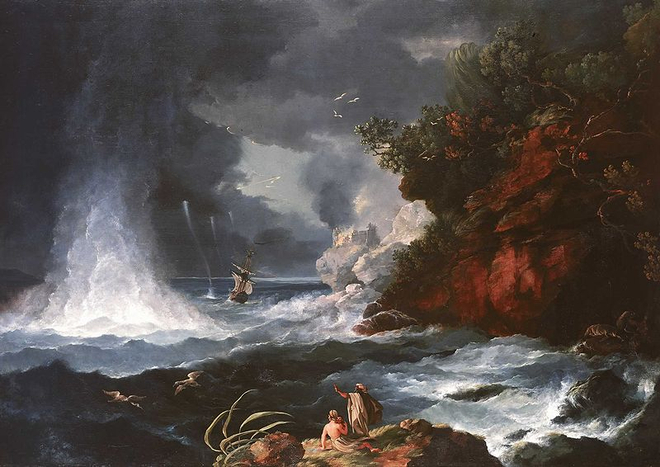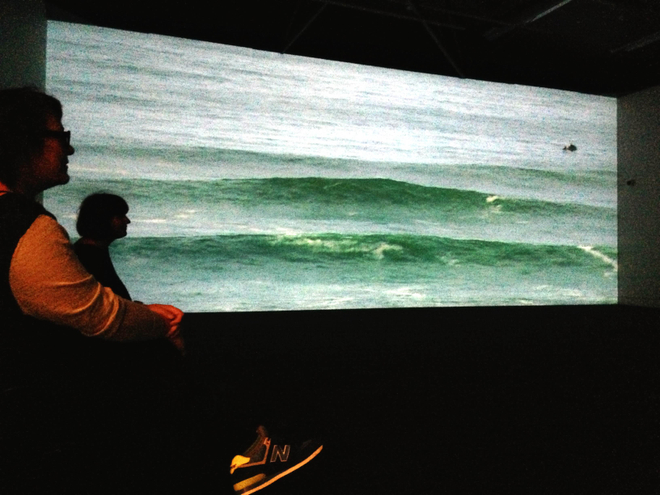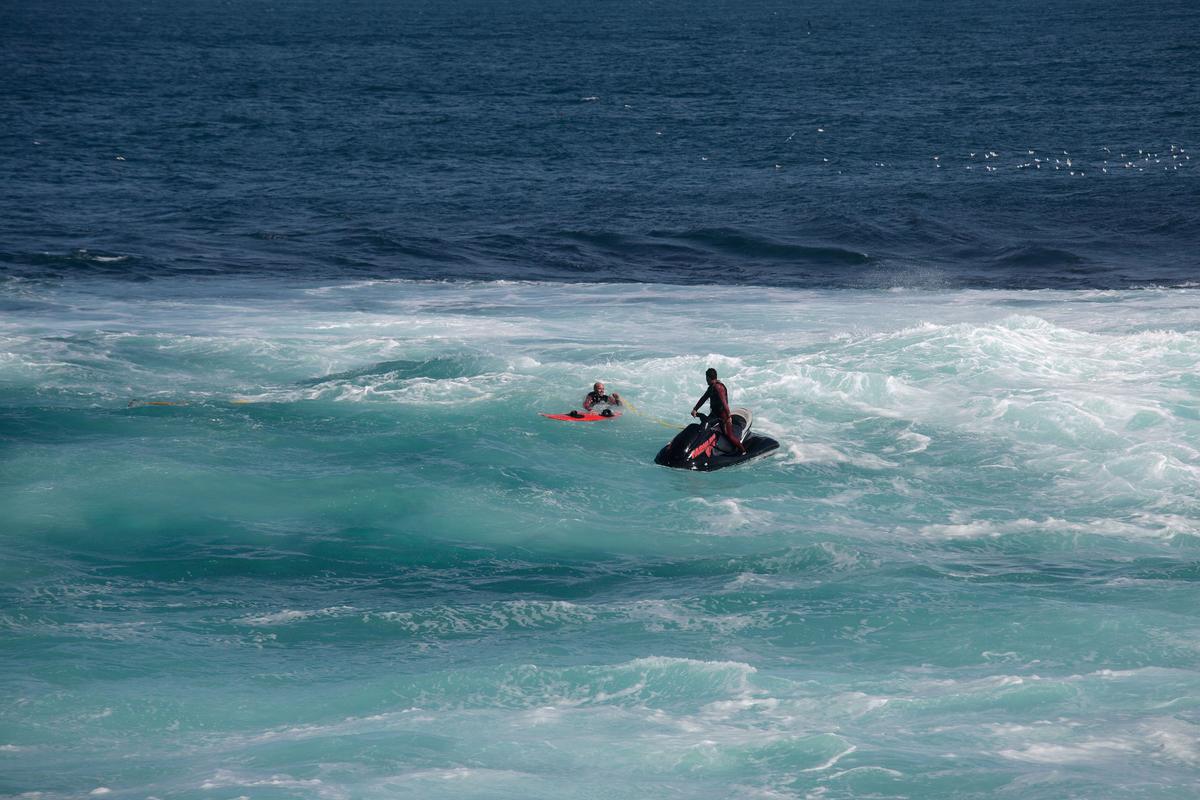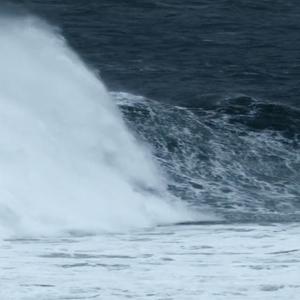The word "immersive" has always been problematic for me. I think because in some instances it has been anaesthetised by art speak (and I am guilty of this as much as anyone). A video installation or a sculptural installation is often described as "immersive" simply because it takes up a large space, or uses a variety of layered materials, or bright, confrontational colours, or loud sound, or fast-paced, flickering images.
Much art that is described as "immersive" is in fact, the opposite. You can’t touch it, or hold it, or roll around in it, or rub your cheek against it. The senses you are permitted to experience it with are sight and sound. The word "immersive", with its semantic connotations of liquid and depth, implies something beyond that—a haptic experience that moves outside of the optical sheen of the digital surface.
The framing of Alex Monteith’s new moving image work, Big Wave Aotearoa (2013), at the Dowse Art Museum also messes with the expectations of digital depth one might have when approaching her work. Though a single channel projection, the work is still huge, taking up the entire back wall of the Dowse’s large, square gallery. Big Wave Aotearoa shows the ocean rising, surging, and crashing down relentlessly in the foreground of the screen. Amongst the tumult, tiny surfers and their colleagues on jet skis flit through the seascape, darting across and over the ocean. They wait patiently at the periphery of the projection, then they dash across the sea in dogged attempts to catch the enormous waves as they roll in.
The narrative of the work—the relentless desire to pursue and tame (understand?) these huge waves—is compelling. There are minutes of open, peaceful time when you are lulled into the rhythm of the waves rolling towards the shore. Then a huge wave comes—usually they appear in a group of three or four—and the tiny surfer speeds across the water to catch them. And they do. Or they don’t. How long will they be able to stay up for? They look puny. How could they ever survive this torrent of rushing water?
I can’t help but use these furious verbs and adverbs when writing about Big Wave Aotearoa. The waves seethe. The surfers speed. The sea rolls relentlessly against the shore. It has the drama of a sibilant Tolstoy novel. The digital sublime. This write up is turning a bit Tolstoy-esque itself.
Anyway, it is mesmerising. It isn’t hard to spend a long time watching the work; getting caught up in its repetitive behaviours and narrative cycle of peaks and troughs; in its tension and its quick activity.
Though this is a single channel projection, the word "immersive" is often attributed to a large moving image works such as Big Wave Aotearoa. However, Big Wave’s tight framing restricts the work’s "immersive" quality—and this is, I think, important. Monteith doesn’t allow you to see the beach, in the foreground of the projection the sea is cut off before the sand appears. This framing throws the perspective of the work strangely off kilter. You can’t quite determine the size of the viewer in relation to the ocean. They look tiny and enormous at the same time. At times you get the sense you are watching a small puddle, which you could reach down and easily splash away if you had to.
This work can read within a history of other forms of New Zealand’s historical sublime. In a William Hodges painting for example, the figures are usually minute in comparison to the landscape they inhabit, normally caught against a cascading waterfall or on the edge of a deep ravine. Take this work for example, A View of Cape Stevens in Cook’s Strait (New Zealand) with Waterspout (1776):

A View of Cape Stephens in Cook's Straits (New Zealand) with Waterspout (1776) William Hodges
Here, humans have very little agency against the forces of nature. Hodges depicts the ocean as an unknowable and dangerous system against which human fears are projected and through which they are filtered. Symbols of human progress—the disintegrating castle (struck by lightening?), the flimsy boat—are of no consequence in the tumult of nature. The strangely Grecian New Zealanders look on, unable to affect the events that will unfold with a relentless inevitability.
It may seem a leap, but I kept thinking of this painting by Hodges when I was watching Big Wave Aotearoa, and the way in which it references and updates Hodges’ early, colonial Romanticism. Re-framed and re-organised by the temporal repetition allowed by digital moving image, and filtered through the discourse of high-level competitive sports, humans and the ocean engage in a different contest in Big Wave Aotearoa. The carefully collapsed perspective of Monteith’s new digital world is a space in which humans are simultaneously dominated by and dominating of the seascape.

Installation view of Big Wave Aotearoa (2013) Alex Monteith
This lack of clear perspective sets the work spinning between "immersive" and an impenetrable, moving image. Whilst I was watching Big Wave Aotearoa some kids figured this tension out before I had. The Dowse has prescribed the viewer’s experience by placing seats far back, on the opposing wall from the work. The kids who were there at the same time as I was kept sitting down on the seats, then running up to the projection on the wall and pressing their hands and faces against the work, then running back to their seats to watch the work from afar.
I think my point is (beyond semantic quibbling), that Monteith’s work invites this ‘immersion’ (its repetition, its size, its looped, surging soundtrack) but it doesn’t solely aspire to it. Big Wave Aotearoa repeatedly reflects on its own existence as a moving image, or perhaps an impassive documentation of extraordinary, awe inspiring, events. This oscillation between depth and surface puts the work in an interesting continuum of structuralist filmmakers who simultaneously create moving images and interrogate the parameters of their medium. The work invites you inside, but asks you to keep your wits about you.

